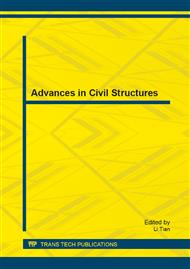p.1207
p.1217
p.1222
p.1226
p.1231
p.1236
p.1240
p.1244
p.1249
Comparative Study of Model Test and Numerical Analysis on the Temperature Monitoring of Mass Concrete Raft Foundation
Abstract:
A high-rise building with an 11 meters thick raft foundation will be built in Shenyang, which will bring a huge challenge to construction on site. To avoid temperature crack affecting construction quality, a comparative study of model test and numerical analysis about temperature monitoring are carried out to determine the construction measures for the mass concrete mat foundation. The results show that the development of temperature field of inner concrete can be divided into three stages: growing rapidly, cooling fast and cooling steadily. Different temperature control measures should be used for different temperature developing stages. The results of the model test and numerical analysis in the paper will provide technical supports to the temperature control on site.
Info:
Periodical:
Pages:
1231-1235
Citation:
Online since:
August 2013
Authors:
Keywords:
Price:
Сopyright:
© 2013 Trans Tech Publications Ltd. All Rights Reserved
Share:
Citation:


